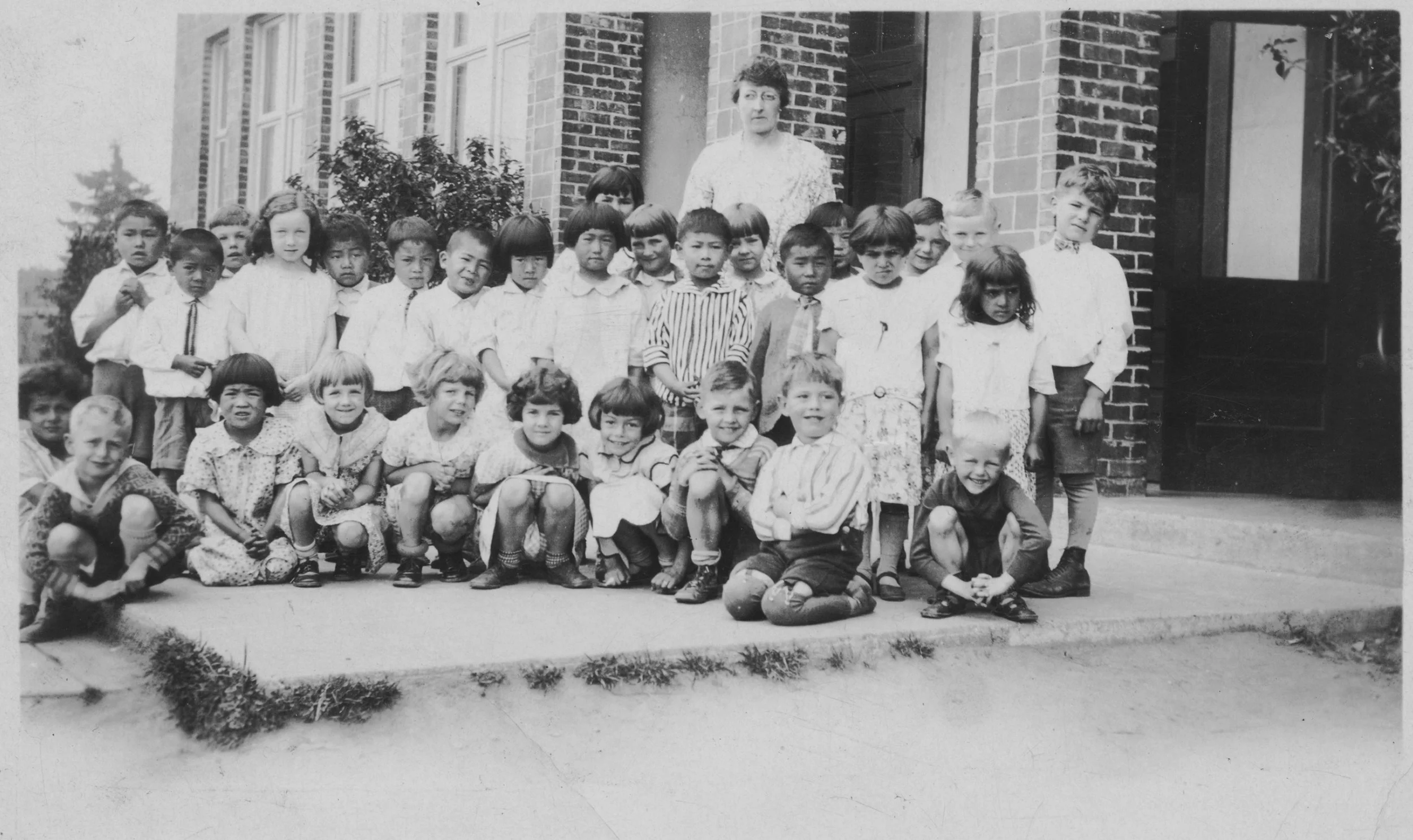Eastside Stories is our way of sharing Eastside history through the many events, people places and interesting bits of information that we collect at the Eastside Heritage Center. We hope you enjoy these stories and share them with friends and family.
Anyone driving around the Bellevue area these days is familiar with the sight of new school buildings rising to completely replace those built not so very long ago, in the 1950’s and 60’s when the Eastside’s population was soaring. So it’s something of a surprise to discover that here and there remnants of the truly early school buildings live on, hidden in unexpected places.
One of those early buildings is the Factoria School, built in 1929 on the side of the hillside overlooking what is now the I-90/ I-405 interchange. An even earlier schoolhouse, a good-sized frame building, had been built in 1901, creating tiny Factoria School District #134, which never comprised more than one school. At that time, the east-west route where I-90 now lies was a trail connecting Mercer Landing at Enatai to Robinson Landing on Lake Sammamish People moving north and south went most easily by boat on Lake Washington. So it is perhaps not surprising that the schools that existed in those days served just their very immediate communities of farmers, loggers, and coal miners. In 1901 the closest school houses to Factoria were at Wilburton, Newcastle, and near Phantom Lake.
1989.05.04, photo of schoolchildren on steps of school, 1924
In 1929 the original school house burned down and was replaced by a brick structure containing four classrooms. A cement lintel over the front door was incised with the school’s name. In 1942 District #134, along with five other local districts plus Union S High School, consolidated to become Overlake School District. Wartime brought other changes as well. Factoria School was closed and turned over to the Army for use as a barracks. It was also one of several locations on the Eastside that received loads of sand that residents were directed to pick up and keep on hand in case anticipated bombings caused fires. The building was returned to the school district after the war and reopened in 1950 as part of newly created Bellevue School District #405.
2005.0280.158, building after sale in 1961
In the early 1950’s settlement was still sparse east of what is now I-405: Somerset, Eastgate and Lake Hills lay in the future. Factoria’s students, first through fourth graders in four classrooms, came largely from the communities of Norwood Village, Horizon View and Hilltop plus families along Newport Wa, Richards Road, and the lake shore south to Hazelwood. They moved to Enatai School after fourth grade. One resident who attended the school at that time recalled the year that the entire school went all in for the March of Dimes. Kids brought in dimes that were stuck onto a long roll of adhesive tape, marked on the back with a different color for each grade. They raised $65.10 and also wrote letters to children at Children’s Orthopedic Hospital in Seattle who were polio patients. (In those years the fear of contracting polio was very much on children’s minds.)
2013.046.086, Factoria School fire, 1960
In 1957 a larger school, Woodridge Elementary, opened, and little Factoria School was dedicated to special services personnel but still served as a polling place for two precincts. In 1960 it burned but wasn’t destroyed. In 1961 the school district sold the building to Farwest Electronics. The lintel inscribed “Factoria” was cut away and eventually donated to the Bellevue Historical Society. For several years it rested beneath trees at Woodridge Elementary. When that school was torn down and replaced with a new structure in 2008, the lintel was returned to the Eastside Heritage Center, where it now resides, safe and dry but quite unobserved, in the basement of McDowell House.
And what of the old school building? Against all odds, it would seem, it still lives on. S.E. 32nd St. dead ends beyond East Shore Unitarian Church in front of a contemporary looking building housing Seattle King County Realtors Association and other offices. Hidden beneath the new façade, the old brick building, now 90 years old, continues to serve a useful purpose to yet another resident on Woodridge Hill.
By: Margaret - EHC Volunteer
Special thanks to Mary Ellen Piro for previous research into this topic. She left her notes and findings to EHC.
Our Mission To steward Eastside history by actively collecting, preserving, and interpreting documents and artifacts, and by promoting public involvement in and appreciation of this heritage through educational programming and community outreach.
Our Vision To be the leading organization that enhances community identity through the preservation and stewardship of the Eastside’s history.



























